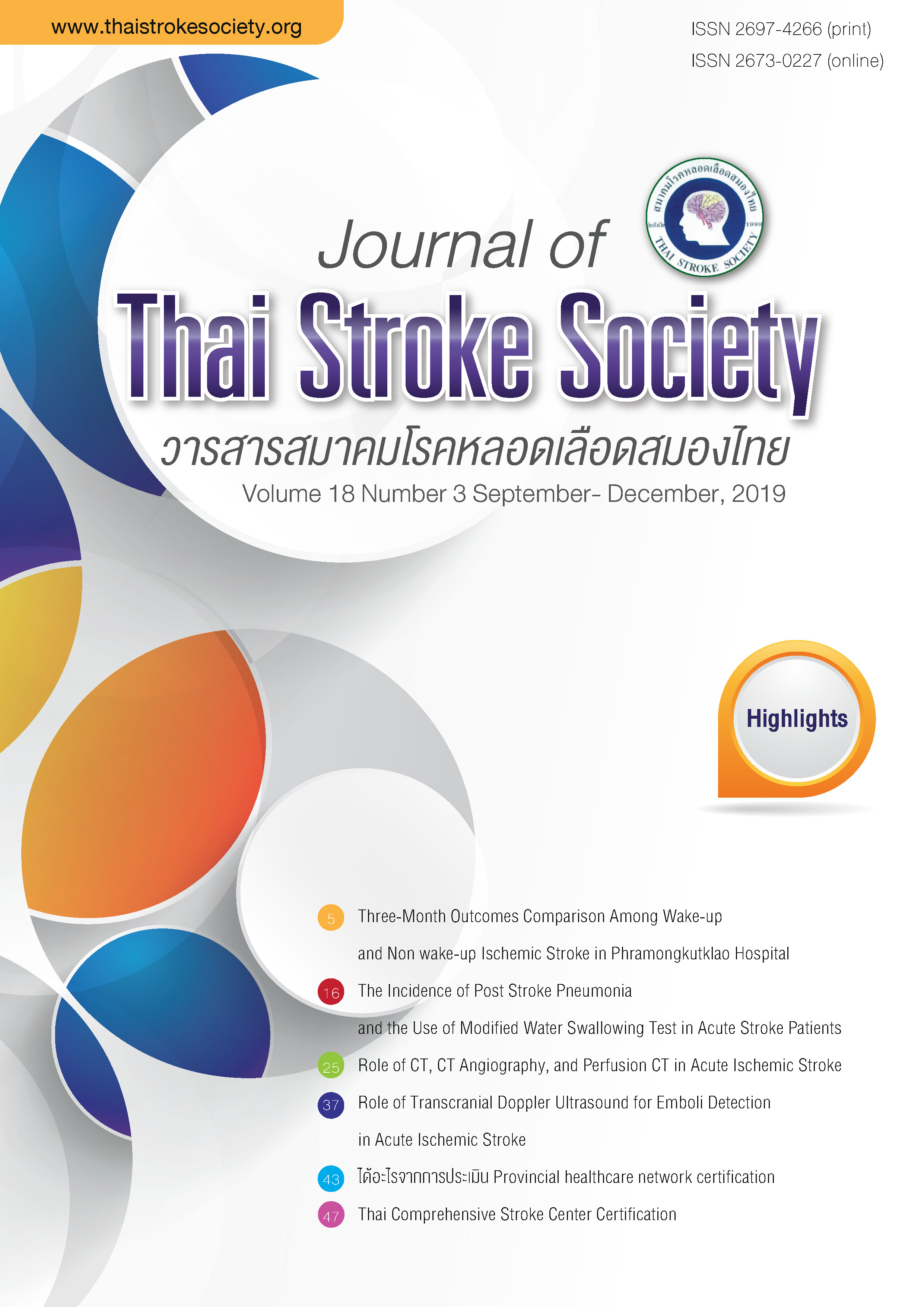Three-Month Outcomes Comparison Among Wake-up and Non wake-up Ischemic Stroke in Phramongkutklao Hospital
Keywords:
ischemic stroke, non wake-up stroke, outcome, wake-up strokeAbstract
Background and Objective: Stroke symptoms noticed upon waking, wake-up ischemic stroke, account for up to a quarter of all acute ischemic stroke. Patients with wake-up ischemic stroke, however, are often excluded from thrombolytic therapy due to stroke onset time is unknown, and these patients revealed worse outcomes. The objective was to investigate the 3-month favorable outcomes between wake-up and non wake-up ischemic stroke, as defined by modified Rankin scale 0-2 (mRS 0-2).
Materials and Methods: A prospective cohort study was conducted at Neurological division, Phramongkutklao Hospital. All patients of age group 18 years or more presenting with acute ischemic stroke during August 2016 to May 2017 were enrolled. Demographic data, clinical presentation, severity, treatment, and outcomes were collected. Three-month favorable outcomes (mRS 0-2) were compared between wake-up and non-wake up ischemic stroke by applying binary logistic regression analysis.
Results: A total of 264 patients diagnosed with acute ischemic stroke were included, of which 100 (37.9%) were wake-up ischemic stroke. Wake-up stroke patients were at a significantly lower percentage to receive thrombolytic therapy (6% vs 14.6%, p-value=0.044). The 3-month favorable outcomes were similar between wake-up and non wake-up ischemic stroke patients, however, wake-up ischemic stroke patients tend to have less 3-month favorable outcome (60% vs 65.2%, p-value=0.431).
References
2. Hanchaiphiboolkul S, Poungvarin N, Nidhinandana S, Suwanwela NC, Puthkhao P, Towanabut S, et al. Prevalence of stroke and stroke risk factors in Thailand: Thai Epidemiologic Stroke (TES) Study. J Med Assoc Thai. 2011;94(4):427-36.
3. Porapakkham Y, Rao C, Pattaraarchachai J, Polprasert W, Vos T, Adair T, et al. Estimated causes of death in Thailand, 2005: implications for health policy. Popul Health Metr. 2010;8:14.
4. Fink JN, Kumar S, Horkan C, Linfante I, Selim MH, Caplan LR, et al. The stroke patient who woke up: clinical and radiological features, including diffusion and perfusion MRI. Stroke. 2002;33(4):988-93.
5. Lago A, Geffner D, Tembl J, Landete L, Valero C, Baquero M. Circadian variation in acute ischemic stroke: a hospital-based study. Stroke. 1998;29(9):1873-5.
6. Chaturvedi S, Adams Jr HP, Woolson RF. Circadian variation in ischemic stroke subtypes. Stroke. 1999;30(9):1792-5.
7. Serena J, Dávalos A, Segura T, Mostacero E, Castillo J. Stroke on awakening: looking for a more rational management. Cerebrovasc Dis. 2003;16(2):128-33.
8. Silva GS, Lima FO, Camargo EC, Smith WS, Singhal AB, Greer DM, et al. Wake-up stroke: clinical and neuroimaging characteristics. Cerebrovasc Dis. 2010;29(4):336-42.
9. Michel P, Odier Cl, Rutgers M, Reichhart M, Maeder P, Meuli R, et al. The acute stroke registry and analysis of Lausanne (ASTRAL) design and baseline analysis of an ischemic stroke registry including acute multimodal imaging. Stroke. 2010;41(11):2491-8.
10. Nadeau JO, Fang J, Kapral MK, Silver FL, Hill MD, Registry of the Canadian Stroke N. Outcome after stroke upon awakening. Can J Neurol Sci. 2005;32(2):232-6.
11. Roveri L, La Gioia S, Ghidinelli C, Anzalone N, De Filippis C, Comi G. Wake-up stroke within 3 hours of symptom awareness: imaging and clinical features compared to standard recombinant tissue plasminogen activator treated stroke. J Stroke Cerebrovasc Dis. 2013;22(6):703-8.
12. Huisa BN, Raman R, Ernstrom K, Tafreshi G, Stemer A, Meyer BC, et al. Alberta Stroke Program Early CT Score (ASPECTS) in patients with wake-up stroke. J Stroke Cerebrovasc Dis. 2010;19(6):475-9.
13. Elliott WJ. Circadian variation in the timing of stroke onset: a meta-analysis. Stroke. 1998;29(5):992-6.
Downloads
Published
How to Cite
Issue
Section
License
ข้อความภายในบทความที่ตีพิมพ์ในวารสารสมาคมโรคหลอดเลือดสมองไทยเล่มนี้ ตลอดจนความรับผิดชอบด้านเนื้อหาและการตรวจร่างบทความเป็นของผู้นิพนธ์ ไม่เกี่ยวข้องกับกองบรรณาธิการแต่อย่างใด การนำเนื้อหา ข้อความหรือข้อคิดเห็นของบทความไปเผยแพร่ ต้องได้รับอนุญาตจากกองบรรณาธิการอย่างเป็นลายลักษณ์อักษร ผลงานที่ได้รับการตีพิมพ์ในวารสารเล่มนี้ถือเป็นลิขสิทธิ์ของวารสาร





